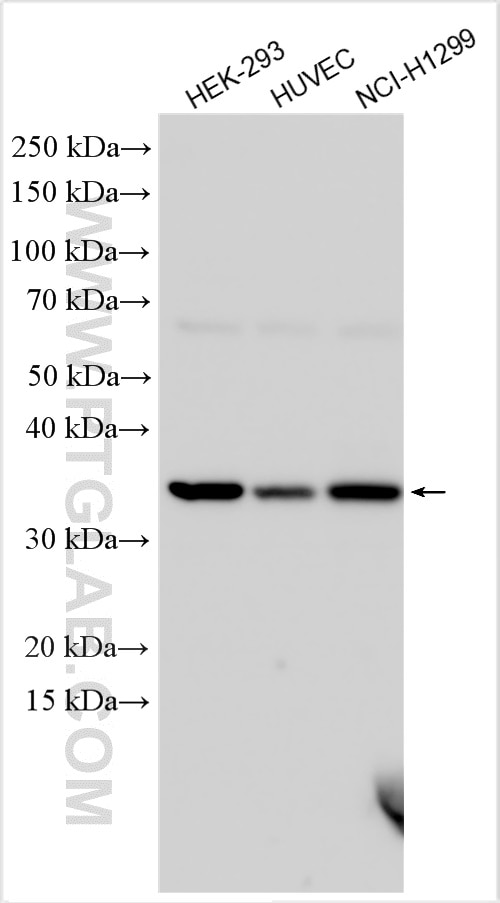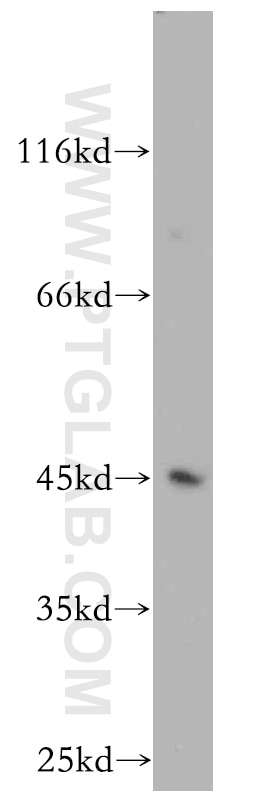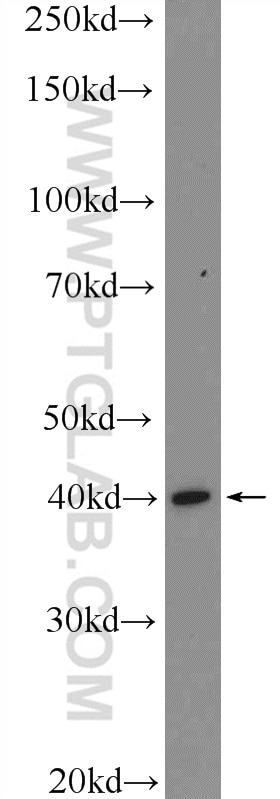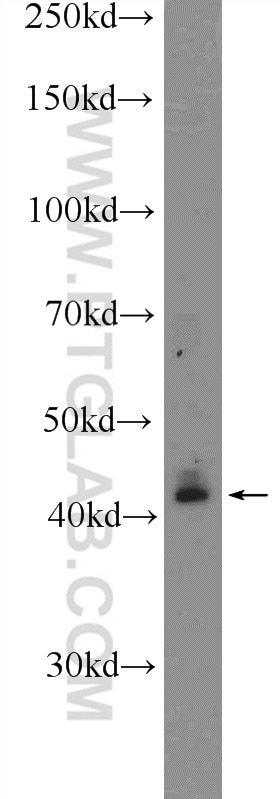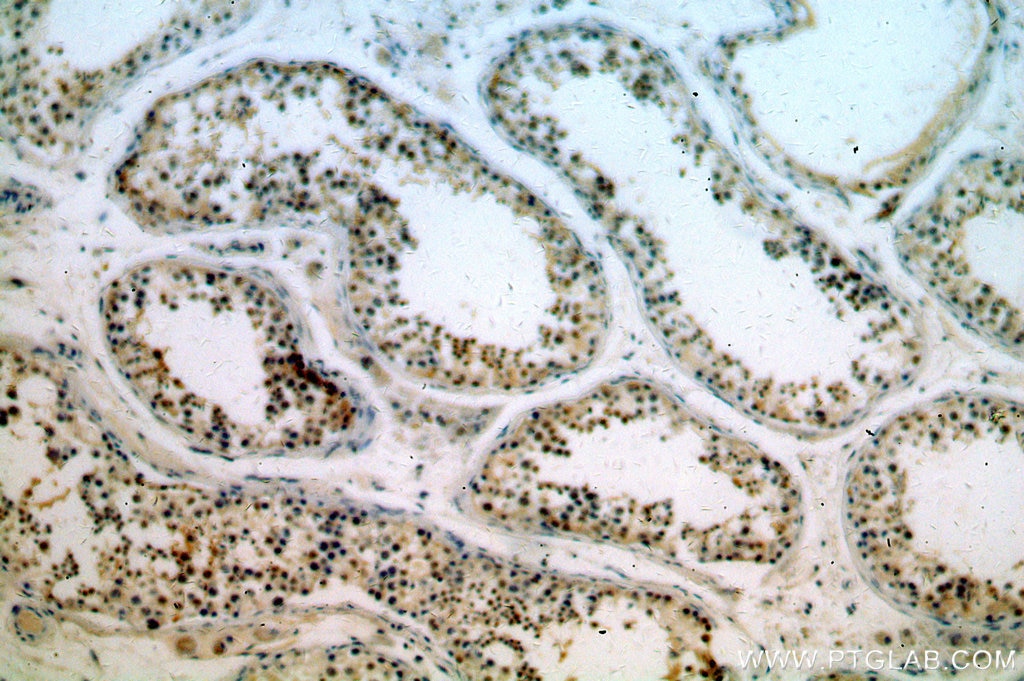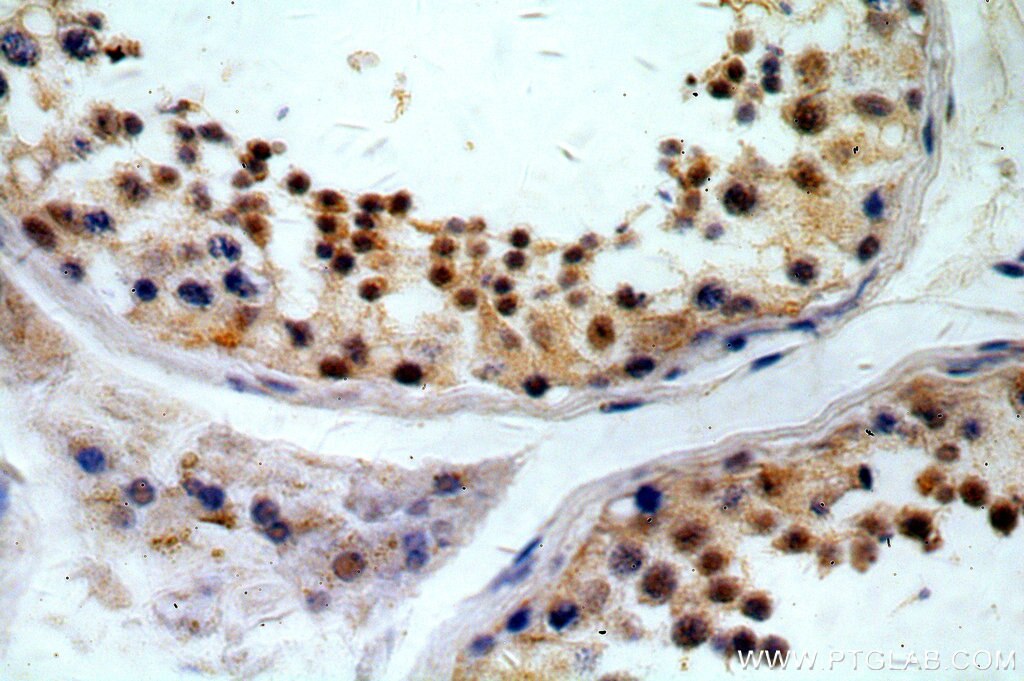- Phare
- Validé par KD/KO
Anticorps Polyclonal de lapin anti-KLF6
KLF6 Polyclonal Antibody for WB, IHC, ELISA
Hôte / Isotype
Lapin / IgG
Réactivité testée
Humain, rat, souris
Applications
WB, IHC, IF, ChIP, ELISA
Conjugaison
Non conjugué
N° de cat : 14716-1-AP
Synonymes
Galerie de données de validation
Applications testées
| Résultats positifs en WB | cellules HEK-293, cellules HUVEC, cellules NCI-H1299, tissu de côlon de souris, tissu de thymus de souris |
| Résultats positifs en IHC | tissu testiculaire humain il est suggéré de démasquer l'antigène avec un tampon de TE buffer pH 9.0; (*) À défaut, 'le démasquage de l'antigène peut être 'effectué avec un tampon citrate pH 6,0. |
Dilution recommandée
| Application | Dilution |
|---|---|
| Western Blot (WB) | WB : 1:1000-1:5000 |
| Immunohistochimie (IHC) | IHC : 1:20-1:200 |
| It is recommended that this reagent should be titrated in each testing system to obtain optimal results. | |
| Sample-dependent, check data in validation data gallery | |
Applications publiées
| KD/KO | See 1 publications below |
| WB | See 20 publications below |
| IHC | See 3 publications below |
| IF | See 5 publications below |
| ChIP | See 1 publications below |
Informations sur le produit
14716-1-AP cible KLF6 dans les applications de WB, IHC, IF, ChIP, ELISA et montre une réactivité avec des échantillons Humain, rat, souris
| Réactivité | Humain, rat, souris |
| Réactivité citée | rat, Humain, souris |
| Hôte / Isotype | Lapin / IgG |
| Clonalité | Polyclonal |
| Type | Anticorps |
| Immunogène | KLF6 Protéine recombinante Ag6440 |
| Nom complet | Kruppel-like factor 6 |
| Masse moléculaire calculée | 32 kDa |
| Poids moléculaire observé | 32-42 kDa |
| Numéro d’acquisition GenBank | BC000311 |
| Symbole du gène | KLF6 |
| Identification du gène (NCBI) | 1316 |
| Conjugaison | Non conjugué |
| Forme | Liquide |
| Méthode de purification | Purification par affinité contre l'antigène |
| Tampon de stockage | PBS with 0.02% sodium azide and 50% glycerol |
| Conditions de stockage | Stocker à -20°C. Stable pendant un an après l'expédition. L'aliquotage n'est pas nécessaire pour le stockage à -20oC Les 20ul contiennent 0,1% de BSA. |
Informations générales
KLF6(krupple-like factor 6) is a zinc finger transcription factor and tumor suppressor with biological activities and transcriptional targets in growing range. It is highly expressed in placenta followed by spleen, thymus, prostate, testis, small intestine and colon. One key target gene of KLF6 in endoglin, which is a homodimeric cell membrane glycoprotein and TGF-β auxiliary receptor, owns a pro-angiogenic role in endothelial cells and is also involved in malignant progression. Also KLF6 induces apoptosis in prostate cancer cells through upregulation of ATF3. KLF6 has 3 isoforms with the molecular mass of 32, 31 and 26kDa. KLF6 was normal detected as a 46kDa protein, which is larger than translation product(32kDa), because of post-translational modification including both phosphorylation and glycosylation. This antibody raise against the full length of KLF6 gene of human origin, and can recognize both of KLF6, included KLF6(~32kDa), p-KLF6(~35-46kDa), Highly ubiquitinated KLF6(~60kDa). Otherwise, there may be a non-specific band(50kDa) showed in detection
Protocole
| Product Specific Protocols | |
|---|---|
| WB protocol for KLF6 antibody 14716-1-AP | Download protocol |
| IHC protocol for KLF6 antibody 14716-1-AP | Download protocol |
| Standard Protocols | |
|---|---|
| Click here to view our Standard Protocols |
Publications
| Species | Application | Title |
|---|---|---|
Adv Sci (Weinh) Exosomal miR-181d-5p Derived from Rapamycin-Conditioned MDSC Alleviated Allograft Rejection by Targeting KLF6 | ||
Nutrients The Growth of SGC-7901 Tumor Xenografts Was Suppressed by Chinese Bayberry Anthocyanin Extract through Upregulating KLF6 Gene Expression. | ||
J Ethnopharmacol Salvia miltiorrhiza bunge exerts anti-oxidative effects through inhibiting KLF10 expression in vascular smooth muscle cells exposed to high glucose. | ||
Front Genet Revealing Potential Spinal Cord Injury Biomarkers and Immune Cell Infiltration Characteristics in Mice. | ||
Front Physiol MiR-181d-5p Targets KLF6 to Improve Ischemia/Reperfusion-Induced AKI Through Effects on Renal Function, Apoptosis, and Inflammation. | ||
Bioengineered MicroRNA-124 modulates neuroinflammation in acute methanol poisoning rats via targeting Krüppel-like factor-6. |
Avis
The reviews below have been submitted by verified Proteintech customers who received an incentive for providing their feedback.
FH Paulo (Verified Customer) (03-01-2019) | Used to perform ChIP-seq in ccRCC cell lines. 20ug of antibody used in 100million cells. No peaks were detected in known target genes and obtained peaks failed to present the consensus KLF6 binding site after motif analysis.
|
